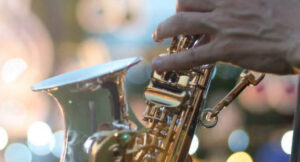
Pasadena nonprofit Clazzical Notes aims to enlighten audiences with the significance of the Harlem Renaissance with a special experience called “Black Mecca” on Friday, Feb. 10.
The Harlem Renaissance was a significant period of growth and development for the African American community that flourished from the 1910s throughout the 30s – it was hailed as the Cultural and Artistic Revival of Black America.
The movement was centered in Harlem, Manhattan, and other boroughs of New York City, earning Harlem the title of the “Black Mecca” at the time.

Lena Kennedy, sister of the Late Councilmember John Kennedy, pidctured with Jerri Price-Gaines, Founder and Executive Director of Clazzical Notes.
The period saw intellectual and cultural revival of African American music, dance, art, fashion, literature, theater, politics and scholarship.
With “Black Mecca,” Clazzical Notes intends to inform and remind people of some periods in U.S. history that were part of the Harlem Renaissance.
“Between the 1920s through the 1930s, that era is known as Black Mecca, because it basically indicated the great migration of many African-Americans leaving the South, where there was so much violence and discrimination and everything that we know about at that time, and moving north for better jobs and just a better way of life,” said Jerri Price-Gaines, Founder and Executive Director of Clazzical Notes.
“Many of these people turned out to be or became the great legends of music and intellectuals and artists and poets. And this is what became Black Mecca.”
African Americans brought their culture and music with them during that migration, and many names became part of Black cultural history: dance and band leaders and intellectuals such as Langston Hughes and W. E. B. Du Bois, and dancers like Josephine Baker, and singers like Billie Holiday and Bessie Smith.
“They were all people that – whether or not we lived during that time – we know of today,” Price-Gaines said. “Because they made such a positive impact into how African-Americans were to think of themselves – because of this intellectual brain trust that they brought.”
Clazzical Notes will stage present-day musicians from all across Southern California performing music of the Harlem Renaissance period at the Alkebu-lan Cultural Center at 1435 N. Raymond Ave. in Pasadena.
Among these musicians are Pasadena-born trumpeter and producer Nolan Shaheed, drummer Marvin Smitty Smith, pianist and composer Theo Saunders, saxophonist Ricky Woodard, bassist Tony Dumas, dancer Brittany Daniels, and vocalist Sylvia MacCall.
The audience will know and hear what the Harlem Renaissance was all about.
“I think we’ve always heard Harlem Renaissance, but I don’t know if everyone realizes the significance of that from African-American history,” Price-Gaines said. “They’ll all know the names of Duke Ellington – who doesn’t know Duke Ellington? – and Louis Armstrong and Bessie Smith and Charlie Parker. That kind of music will be played. And they will know why they were important during that particular time.”
Harlem Renaissance, as described by Britannica, was a blossoming of African American culture, particularly in the creative arts, and the most influential movement in African American literary history.
Embracing literary, musical, theatrical, and visual arts, participants sought to create a new concept of the African American apart from the white-initiated stereotypes that had influenced Black peoples’ relationship to their heritage and to each other. They also sought to break free of Victorian moral values and bourgeois shame about aspects of their lives that might, as seen by whites, reinforce racist beliefs.
While the renaissance was not confined to the Harlem district of New York City, Harlem attracted a remarkable concentration of intellect and talent and served as the symbolic capital of this cultural awakening.
During the program, the audience will hear a lot of great music, Price-Gaines said.
“They will hear great, great poetry, they will see great dancing, and probably at the end of the program, we’ll open it up to questions and answers,” she continued. “It may be especially for students, because students can come for free. We do want them to know of this particular time. It’s such an important time. But if there are people who want to, when the program is over is our Q&A time to be able to ask questions.”
The program on Feb. 10 is free of charge, although Clazzical Notes would appreciate a suggested $20 donation. People can pay on EventBrite or through the organization’s website, www.clazzicalnotes.org. To make a donation, visit www.flipcause.com/secure/classic/MTc0NDI1.
For more information, visit https://www.clazzicalnotes.org/ or call (626) 833-2750.





